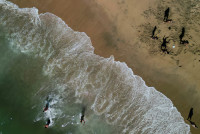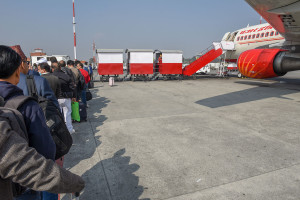Climate & Environment
Wetlands across Nepal see decline in waterbird population
Preliminary findings from the waterbirds census show that their population has gone down, mainly due to habitat loss and other human activities, according to experts.
Chandan Kumar Mandal
The country has seen a decline in the population of waterbirds this year, preliminary findings from the waterbirds census 2021 show.
While populations have increased in some areas, others have registered declines, said the organisers of the census, conducted mainly in wetland areas of the Terai along with major lakes, ponds, and rivers throughout the country
“If we look at the wetland sites, then the total number has gone down. At some sites, the number has increased as well. Still, the overall population has declined compared to last year,” said Hem Sagar Baral, national coordinator for the census.
Ornithologist Baral, who is also the national coordinator for Wetlands International that conducts the census in Asia, said, “Wetlands sites like the Jagdishpur lake, which is a crucial habitat for waterbirds, have registered declines in the number of individuals.”
The last census showed 70,000 waterbirds—both residents and migratory—belonging to almost 50 species were found in the country.
Most of the sites—from east to west—have recorded a dwindling population of waterbirds.
In Chitwan, waterbird populations in Lothar-Golaghat, which were divided into four small patches, were also found to have declined, said Ramesh Chaudhary, president of Bird Education Society, which led the count in Chitwan.
“We have completed the count and are now processing the data. But the number of waterbirds seems to have decreased this year,” said Chaudhary. “The number of waterbird species has come down to 53 from 57 recorded during the 2020 census. However, some species that were not sighted last year have also been sighted this time.”
According to Chaudhary, dunlin, which was never sighted during waterbird censuses in the past, was found during this year’s count. Likewise, greater white-gronted geese, a rare vagrant species for Nepal was also sighted this time. In Chitwan, ruddy shelduck (chakhewa) and great cormorant were recorded in the highest numbers.
A similar decline in the number of waterbirds has been seen in the wetlands of Pokhara.
According to Mann Shanta Ghimire, president of Pokhara Bird Society, the count carried out in the lake clusters of Pokhara, which includes the city’s nine lakes, and Bijayapur Khola, showed the number has gone down significantly.
“Waterbird species look fine but the total number seems to have gone down significantly,” said Ghimire. “We are still verifying our data, but we can say that number surely has decreased.”
The count has also been disappointing in western Nepal. In Bardia, where the census was conducted in six sites, a total of 1,121 waterbirds were sighted this time. In the Karnali basin, 303 waterbirds of 21 species were recorded this time. Likewise, 860 waterbirds of 35 species were found in the Geruwa river, 19 birds of six species in the Babai, 36 birds of nine species in Satkhaluwa, and 34 species, according to Ram Shahi, president of Bardia Nature Conservation Club.
“Fewer individuals, as well as species, have been recorded this time than the previous year,” said Shahi. “A major habitat in Badhaiya Lake has seen its water level decline, whereas pollution has gone up in the Karnali. Also, there is noise pollution around Badhaiya Lake, which has become a picnic spot .”
In eastern Nepal, the number of waterbirds has slightly increased compared to last year. The count found 19,545 waterbirds representing 63 species in Koshi Tappu and its adjacent wetland areas.
Last year, a total of 16,012 water birds were recorded from 61 species. Here, the total population of waterbirds increased by 22.06 percent compared to the last year.
The annual count was conducted in Koshi Tappu Wildlife Reserve and its adjacent wetlands in Barahkshetra Municipality, Koshi Rural Municipality, Barju Lake and Tarahara of Sunsari, Mangalbare and Betana wetland areas of Morang, Koshi Barrage, Bhardaha wetland areas and Kamalpur Lake of Saptari, and Bhagalpur wetland area of Udaypur.
“The number of waterbirds in the Koshi area has increased from last year but still shows a decline from the past years,” said Sanjib Acharya, president of Koshi Birds Society. “We have recorded some waterbird species which are not new for Nepal, but were sighted after several years. For example, the baikal teal was sighted after eight years.”
More than half of the total number was recorded in Barju Lake alone. Likewise, a total of 4,908 waterbirds representing 51 species were recorded in Koshi Tappu Wildlife Reserve among which the ruddy shelduck was the most abundant (1,157 individuals).
Similarly, a total of 2,472 waterbirds were recorded from areas outside the reserve area and Koshi Barrage. Ruddy Shelduck was recorded more frequently (540 individuals) than others.
Barju Lake of Sunsari is considered a crucial habitat for waterfowl species. A total of 11,025 birds representing 37 species were recorded from this area among which the most recorded was the Common Teal (5,135) followed by the Lesser Whistling Duck (4.350).
Koshi and adjacent areas recorded 7,380 of 56 species of waterbirds, recording an increase by 31.36 percent, and also one more species is recorded than last year.
“Over the years, the number of waterbirds saw a decline in the area, owing to the excessive growth of vegetation in the wetlands areas, drying up of wetlands and farming in those areas, increasing human disturbances, fishing practices,” said Acharya. “Also, picnic spot, construction works, vehicular movement, and honking horns have affected waterbirds around the Koshi barrage area.”
Nepal welcomes around 150 migratory birds every year. However, more than 100 of them are waterbirds whereas the remaining ones are grassland and forest birds. These waterbirds spend their trip in the wetlands of the country.
According to Chaudhary, these migratory birds started entering Nepal in October and stayed until March. This is when these aquatic birds are counted.
Nepal had conducted its first waterbirds counting in 1967. Since then every year citizen scientists and volunteers have been counting the waterbird population in Nepal during the mid-winter waterbird count as part of the Asian Waterbird Census (AWC). This year nearly 300 volunteers took part in this annual event which was hosted by Himalayan Nature from January 2- January 18.
The declining number of waterbirds is attributed to the damage and destruction to their wetland habitats in Nepal and elsewhere, according to experts.
“There are some domestic problems like wetland shrinkage and loss, their habitat quality loss, hunting among others,” said Baral. “Since these waterbirds are also migratory, factors outside Nepal also affect them. For instance, habitat damage, hunting, and climate-driven factors also affect them.”




 9.12°C Kathmandu
9.12°C Kathmandu











